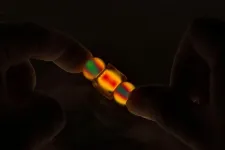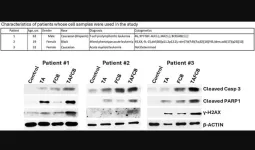(Press-News.org) ITHACA, N.Y. – Pairing cryptocurrency mining – notable for its outsize consumption of carbon-based fuel – with green hydrogen could provide the foundation for wider deployment of renewable energy, such as solar and wind power, according to a new Cornell University study.
“Since current cryptocurrency operations now contribute heavily to worldwide carbon emissions, it becomes vital to explore opportunities for harnessing the widespread enthusiasm for cryptocurrency as we move toward a sustainable and a climate-friendly future,” said Fengqi You, professor of energy systems engineering at Cornell.
You and doctoral student Apoorv Lal are authors of “Climate Sustainability Through a Dynamic Duo: Green Hydrogen and Crypto Driving Energy Transition and Decarbonization,” which published March 25 in the Proceedings of the National Academy of Sciences.
Their research shows how linking the use of energy-intensive cryptocurrency mining with green hydrogen technology – the “dynamic duo,” they call it – can boost renewable energy sectors.
“Building a green hydrogen infrastructure to help produce cryptocurrency can accelerate renewable energy and create a more sustainable energy landscape,” Lal said.
Using clean energy sources to power blockchain mining operations and fuel the production of green hydrogen can lead to growing wind and solar capacity – and expand sustainable energy production across the country, the researchers said.
In its current structure, mining blockchain-based cryptocurrency in the U.S. can use as much carbon-based energy as the entire country of Argentina, according to a 2022 White House Office of Science and Technology report. Nearly all domestic crypto-mining electricity is driven by computer power-hungry consensus mechanisms, known as “proof of work,” which is used to verify crypto-assets.
Preliminary estimates by the U.S. Energy Information Administration suggest that 2023 annual electricity consumption for cryptocurrency mining likely represents from 0.6% to 2.3% of all U.S. electricity consumption.
“Acknowledging the substantial energy demands of cryptocurrency mining, our research proposes an innovative technology solution,” You said. “By leveraging cryptocurrencies as virtual energy carriers in tandem with using green hydrogen, we can transform what was once an environmental challenge into a dynamic force for climate mitigation and sustainability.”
In their research, You and Lal examined individual U.S. states to assess potential energy strengths in each region.
Supporting cryptocurrency can hasten the building of extra energy infrastructure and potentially create 78.4 megawatt hours of solar power for each Bitcoin mined in New Mexico, for example, and potentially 265.8 megawatt hours of wind power for each Bitcoin mined in Wyoming, according to the paper.
“While cryptocurrency currently has a high dollar value (Bitcoin traded for more than $73,000 on March 13,) you cannot hold it in your hand,” You said. “It’s virtual. Think of cryptocurrency and energy in the same way – much like a gift-card concept. Cryptocurrency also can hold an energy value and that becomes an additional function.”
To advance a sustainable future for blockchain-based cryptocurrency, the researchers said, stronger federal policies for climate goals and renewable energy need to advance.
“Coupled with green hydrogen, this approach to cryptocurrency not only mitigates its own environmental impact, but pioneers a sustainable path for renewable energy transition,” You said. “It’s a novel strategy.”
You is a senior faculty fellow at the Cornell Atkinson Center for Sustainability. Funding for this work was provided by the National Science Foundation.
END
Pairing crypto mining with green hydrogen offers clean energy boost
2024-03-25
ELSE PRESS RELEASES FROM THIS DATE:
With a new experimental technique, MIT engineers probe the mechanisms of landslides and earthquakes
2024-03-25
Granular materials, those made up of individual pieces, whether grains of sand or coffee beans or pebbles, are the most abundant form of solid matter on Earth. The way these materials move and react to external forces can determine when landslides or earthquakes happen, as well as more mundane events such as how cereal gets clogged coming out of the box. Yet, analyzing the way these flow events take place and what determines their outcomes has been a real challenge, and most research has been confined to two-dimensional experiments that don’t ...
MinJun Kim inducted into the 2024 Class of the AIMBE College of Fellows
2024-03-25
The American Institute for Medical and Biological Engineering (AIMBE) has announced the induction of MinJun Kim, Robert C. Womack Endowed Chair Professor in Engineering at Southern Methodist University to its College of Fellows.
Election to the AIMBE College of Fellows is among the highest professional distinctions accorded to medical and biological engineers, comprised of the top two percent of engineers in these fields. College membership honors those who have made outstanding contributions to "engineering and medicine research, practice, or education” and to “the pioneering of new and developing fields of technology, making major advancements in traditional ...
Global study could change how children with multiple sclerosis are treated
2024-03-25
A ground-breaking study – the largest of its kind globally – has found children with multiple sclerosis (MS) have better outcomes if treated early and with the same high-efficacy therapies as adults.
There are a limited number of therapies approved for children with MS, with only one considered to be of high-efficacy – meaning highly effective.
However, a Royal Melbourne Hospital (RMH) observational study has determined that paediatric patients should be treated with the same high-efficacy ...
NRL scientists deliver quantum algorithm to develop new materials and chemistry
2024-03-25
WASHINGTON – U.S. Naval Research Laboratory (NRL) scientists published the Cascaded Variational Quantum Eigensolver (CVQE) algorithm in a recent Physical Review Research article, expected to become a powerful tool to investigate the physical properties in electronic systems.
The CVQE algorithm is a variant of the Variational Quantum Eigensolver (VQE) algorithm that only requires the execution of a set of quantum circuits once rather than at every iteration during the parameter optimization process, thereby increasing the computational throughput.
“Both algorithms ...
Bengal cat coats are less wild than they look, genetic study finds
2024-03-25
Bengal cats are prized for their appearance; the exotically marbled and spotted coats of these domestic pets make them look like small, sleek jungle cats. But the origin of those coats — assumed to come from the genes of Asian leopard cats that were bred with house cats — turns out to be less exotic.
Stanford Medicine researchers, in collaboration with Bengal cat breeders, have discovered that the Bengal cats’ iridescent sheen and leopard-like patterns can be traced to domestic cat genes that were aggressively selected for after the cats were bred with wild cats.
“Most ...
Transmasculine people report higher dietary supplement use than general population
2024-03-25
More than 1 million people in the United States identify as transgender; however, there is limited research on nutrition-related health outcomes for transgender people. To narrow the research gap, Mason MS, Nutrition student Eli Kalman-Rome investigated common motivations of dietary supplement use in transmasculine people. The study defined transmasculine as people on the transgender and gender-nonbinary spectrum who were assigned female at birth.
Transmasculine people reported a higher use of dietary supplements (65%) compared to the total U.S. population (22.5%), according to the study. 90% of transmasculine participants reported using supplements ...
Neuroscience and Society Series: aligning science with the public’s values
2024-03-25
Research that involves implanting devices into the brains of human volunteers creates a special moral obligation that extends beyond the trial period—an obligation that researchers, device manufacturers, and funders owe to the volunteers. This is the conclusion of two new essays in the Hastings Center Report that launch a series on the ethical and social issues raised by brain research.
The “Neuroscience and Society” series is supported by the Dana Foundation and will be published in open-access format online over the next three years.
The series seeks to promote deliberative public engagement about neuroscience, writes Hastings Center senior ...
Friend or foe: A closer look at the role of health care algorithms in racial and ethnic disparities
2024-03-25
PHILADELPHIA -- For years, it was harder for Black patients to secure a coveted spot on the national kidney transplant waitlist because a clinical algorithm was making Black patients appear healthier than they were. After a Penn Medicine researcher exposed the problem in 2019—and showed how it exacerbated racial disparities in kidney disease—a national taskforce recommended removing race from the algorithm’s scoring, a move that has quickly been adopted throughout the country in an effort to reduce ...
ABT199/Venetoclax synergism with thiotepa in acute myeloid leukemia (AML) cells
2024-03-25
“[...] the combination of ABT199/venetoclax and Thio enhances the cytotoxicity of (Flu+Clad+Bu) in AML cell lines and leukemia patient-derived cell samples.”
BUFFALO, NY- March 25, 2024 – A new research paper was published in Oncotarget's Volume 15 on March 14, 2024, entitled, “ABT199/venetoclax synergism with thiotepa enhances the cytotoxicity of fludarabine, cladribine and busulfan in AML cells.”
ABT199/venetoclax, an inhibitor of the pro-survival BCL-2 protein, has improved AML treatment. Its efficacy in hematopoietic ...
More exposure to artificial, bright, outdoor nighttime light linked to higher stroke risk
2024-03-25
Research Highlights:
A large study of residents in Ningbo, China, a major city of more than 8.2 million residents, found that exposure to more artificial, outdoor, nighttime light was associated with a higher risk of conditions that affect brain health.
Excessive exposure to air pollution and artificial, bright light at night were both independently linked to a higher risk of developing cerebrovascular disease and having a stroke.
Embargoed until 1 p.m. CT/2 p.m. ET, Monday, March 25, 2024
DALLAS, March 25, 2024 — People continuously ...



